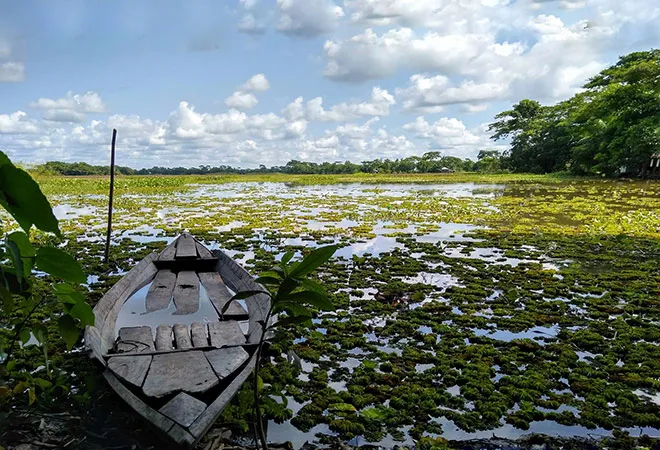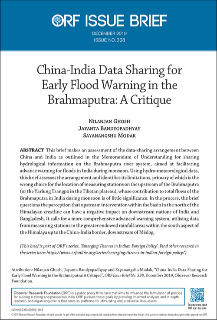
In the event of natural disasters, the local people are usually the worst affected and the first to respond. The concept of Community Based Disaster Risk Reduction (CBDRR) which attempts to dovetail indigenous knowledge for disaster risk reduction and formulate strategies to mainstream the reduction of risk at the community level is therefore increasingly gaining ground. Amongst the South Asian countries, Bangladesh was the first to engage in CBDRR in the aftermath of the deadly Cyclone Bhola of 1970 which caused devastating storm surge flooding that resulted in a massive death toll of around 300,000 to 500,000 people. CBDRR gained further impetus after the floods of 1998, referred to as the ‘flood of the century.’ Indeed floods are almost an annual feature in Bangladesh with its low flat terrain that is barely above sea level, its multiplicity of rivers (almost 80 percent of the country is located in the Ganga-Brahmaputra delta) and a climate heavily affected by monsoons. Naturally, people living in the flood-prone regions have, over time, devised several coping techniques for their survival. However much of this indigenous knowledge is increasingly being lost due to their non-documentation and spread of more modern and foreign technologies. This is a clarion call to document indigenous knowledge and integrate under CBDRR.
Floods are almost an annual feature in Bangladesh with its low flat terrain that is barely above sea level, its multiplicity of rivers and a climate heavily affected by monsoons.
Safer shelters, food, clean drinking water, access to medical services, and clothing are the major requirement of flood-affected communities. Accordingly, the people living in flood-prone regions of Bangladesh have developed coping strategies and techniques through a process of innovation, experience and adaptation — based on their local environment and culture. These practices are passed on from one generation through word of mouth and local practices. These may be understood as follows.
Disaster preparedness strategies
The flood-prone communities prepare themselves well in advance of the monsoon seasons by storing food, clean water and animal fodder as these basic necessities are difficult to obtain in flood situations when mobility becomes restricted. Emergency dry foods like Chira (rice) and molasses are wrapped in polythene and stored in earthen pots. Water purification tablets and portable ovens are also commonly used. Constant vigilance is kept, even at night to monitor the rise of the water level and rafts made of banana trunks are kept ready at hand. Sandbags, frozen cements, and bricks are also kept in readiness as defences against the spread of floods. Apart from such short term disaster preparedness and response measures, the communities have also undertaken measures to increase their disaster risk resilience. Consequently the plinths of their houses are raised on bamboo poles above previously recorded flood levels and they have devised low-cost cluster housing, flood-proof sanitation methods and elevated hand pumps for clean drinking water. The silencer pipes of motor vehicles are also extended above the floodwater level with an L-shaped pipe and frequent use is also made of country boats along with rafts made out of empty barrels.
Alternative means of livelihood
The rural households of districts like Gaibanda, Bogra and Shirajganj have developed a range of alternative flood-resistant income generating activities like floating gardens and nurseries, fisheries in flood water and other small enterprises such as poultry farming. Floating gardens are an age-old practice of crop cultivation in areas where flood water remains for a prolonged period. With the use of water hyacinth and other aquatic weeds, local communities have developed a technique to construct floating platforms on which vegetables and other crops can be cultivated. Farmers use small boats to manage the floating agricultural land.
Community networks
The vulnerable communities have also voluntarily formed Community Based Organisations (CBOs) to help each other in many crisis situations including flood disasters by engaging in search and rescue activities and providing treatment to those affected. The volunteers also organise public dramas, folk songs, rallies and school-based campaigns to raise awareness about floods throughout the year. Often these CBOs are provided training in preparedness measures, capacity building and in providing first aid by government agencies. These agencies supply boats, lifejackets and other equipment and organise community meetings to demonstrate mitigation techniques. These meetings are an effective tool for building a culture of safety; raising awareness and dissemination of early warning signals.
However in the midst of such coping strategies it is interesting to note that some communities don’t consider all floods in a negative light. Often floods are considered to be signs of prosperity and fortune as they bring alluvial soil and communities engage in music and dance to celebrate these. In the north-eastern Haor region (a bowl-shaped naturally depressed water basin), all social and cultural festivities, like marriage, visiting father’s house, and religious meetings are generally held during the floods.
The failure to understand the risk behaviour and indigenous practices of local communities can lead to ill designed preparedness measures on the part of the government.
Nonetheless, it is becoming increasingly necessary to better integrate indigenous knowledge through CBDRR as studies show that since 1970, the scale, intensity and duration of floods have increased in Bangladesh overtime causing grave human suffering, damages to infrastructure, crops and agricultural land. The failure to understand the risk behaviour and indigenous practices of local communities can lead to ill designed preparedness measures on the part of the government. However, the transmission of such knowledge orally, lies at the crux of the problems of integrating indigenous knowledge into mainstream disaster risk reduction strategies. Moreover there are wide varieties and divergences of such knowledge and accordingly these cannot be generalised and recommended for application unless these are tested and found useful in changing contexts.
Indigenous knowledge is now recognised as an under-utilised resource of disaster risk reduction in rural Bangladesh. As has been seen, these strategies include not only techniques of disaster preparedness and response, but also include ways in which the communities are adapting to floods through alternate livelihood strategies. This is a crucial aspect of disaster management in the long run. The vulnerable communities are more confident and comfortable about using their local knowledge in crisis situations and indeed their functional knowledge developed over generations has often proved to be more effective in situations where modern technical methods have been found inadequate. Thus for the successful and nuanced management of natural disasters such as floods it is crucial to understand a community’s unique perceptions and practices and not only integrate their local practices with the more modern and technical measures of disaster management but also to strike a balance between the two. As the disaster risk of floods increases in Bangladesh due to climate change the urgency of aligning indigenous knowledge with mainstream disaster risk reduction strategies under the gamut of CBDRR also rises in tandem.
Neethu Anna Saji is research intern at ORF Kolkata.
The views expressed above belong to the author(s). ORF research and analyses now available on Telegram! Click here to access our curated content — blogs, longforms and interviews.




 PREV
PREV


